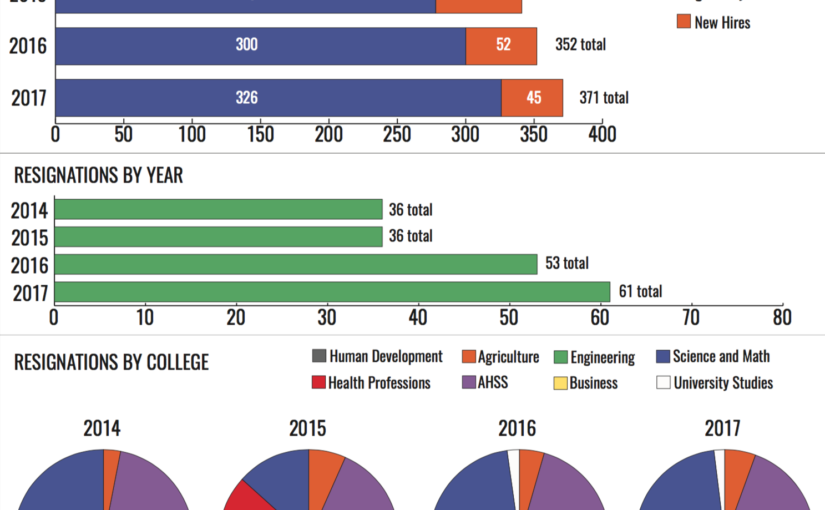THE SPECTRUM | BRENNA MUELLER
The numbers for faculty departures and rehires. As well as a breakdown by college.
Recent budget cuts have put many universities in the Midwest in a state of crisis. The decisions that we make here in Fargo, North Dakota will impact the state, the country and the United States ability to be a technological super power in the future.
North Dakota experienced a budget shortfall after the drop in the price of crude oil. This meant budget cuts for North Dakota State University, who over the past few years has seen a cut between 13 and 14 percent throughout the colleges.
Driving my Honda Civic across the frozen tundra that is North Dakota on an early November day it is obvious that this state offers more acreage for soybean fields than high profile jobs. North Dakota does offer NDSU however, this in turn makes Fargo the hub for knowledge that it is.
NDSU’s roots in research and innovation offer growth potential in Fargo who has seen a boom in population over the past ten years, going from 92,872 in 2007 to 120,767 in 2016. This population growth came with NDSU increasing its own enrollment numbers from 12,527 in the fall of 2007 to 14,432 for fall of 2017. This growth pattern is not a coincidence.
Fargo has also seen openings of major offices such as Microsoft, John Deere and Sanford all opening around our research university. Innovation wants to be by research universities.
Budget cuts have rocked the region as research universities with smaller endowments and no growth patterns are cast in to a shadow of doubt.
According to Dan Reed, the vice president for research and economic development at the University of Iowa, in an article by The Atlantic,
“The good ones will remain competitive. The rest may decline. We spent 150-plus years building a public higher education system that was the envy of the world. And we could in a decade do so much damage that it could take us 30 years to recover.”
The question every student at NDSU and every resident in Fargo should be asking right now, is whether NDSU has survived the budget cuts, and whether we could sustain further cuts. Because NDSU is as important to Fargo as hotdish is on a cold December morning.
The undergraduate students who research
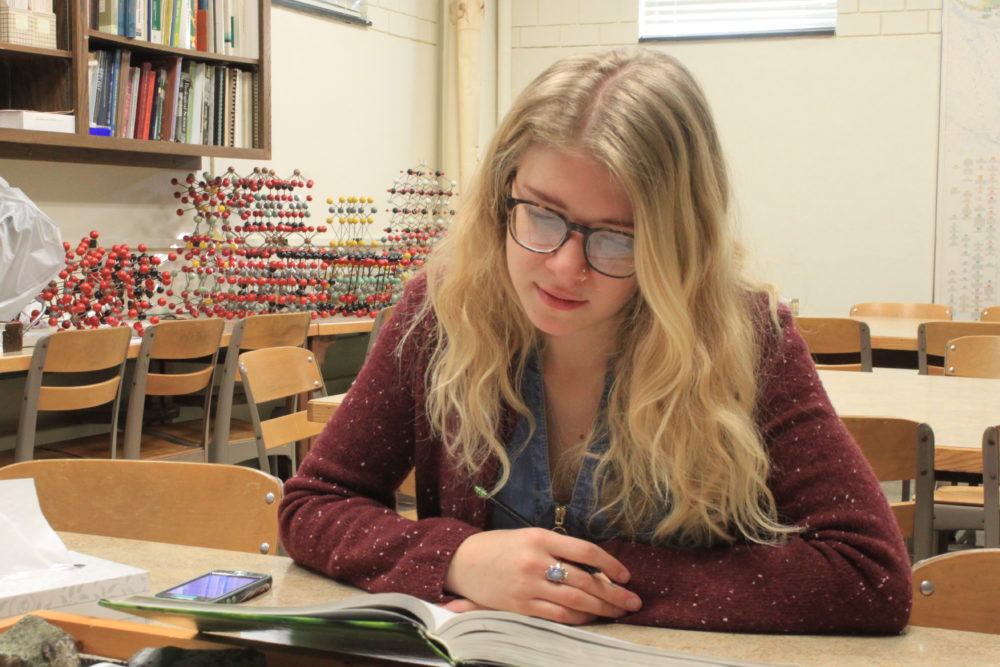
Sara Gibbs Schnucker, a junior majoring in geology told me research aids education.
Sara Gibbs Schnucker is a junior here at NDSU majoring in geology. A student that is involved with two research opportunities, Schnucker made it clear she wanted a particular title.
“You can just call me Sara,” Schnucker is an upbeat student who seems to know everyone. She also knows more about ancient lakebeds than I could ever hope to.
Schnucker is involved with Chronoquest, a student-centered research opportunity and she also assists a professor in research as well.
Schnucker and I met for coffee to discuss her research here at NDSU. Schnucker informed me that I, including the entirety of NDSU was lying at the bottom of an ancient lake. Her and a group of students drove out about 50 minutes to collect dirt for examination.
“You can’t call dirt, dirt… soil scientists will get mad at you, it is soil.”
Okay Sara, soil.
The passion she showed for the geology of an ancient lake was a lot considering she had driven from Duluth at five in the morning to make the interview. She also confirmed to me that she had no coffee in her system.
Between all of the talk of clams and ancient lakes we must ask, how is this research relevant though? Why should we care? How does research affect education?
“I feel like students get really locked into a certain way of going through education… You do the homework you need to get the grade you need to graduate, to go where you want to… but doing research kind of throws a giant monkey wrench in the middle of all of that.”
This is something that is vital to education according to Schnucker. She notes that her research has led her to better questions in class.
“I take a more active role in my education rather than passively getting the grade I need to.”
So, does research affect education?
“I think it is really important for a university to be creating and churning out students that are actually passionate about what they are learning.”
Since the school year of 2014 though NDSU has had 186 full-time faculty members leave. NDSU is in the middle of a generational shift of faculty. According to the numbers, the amount of rehires in the past four years is 215 with voluntary resignation rates rising since 2014.
To the common eye it would be easy to ask if the new staff is as qualified as whom they are replacing. How are we attracting the best faculty possible? How do we seek to keep the faculty who are leading innovation?
Faculty, staff and graduate students who lead research
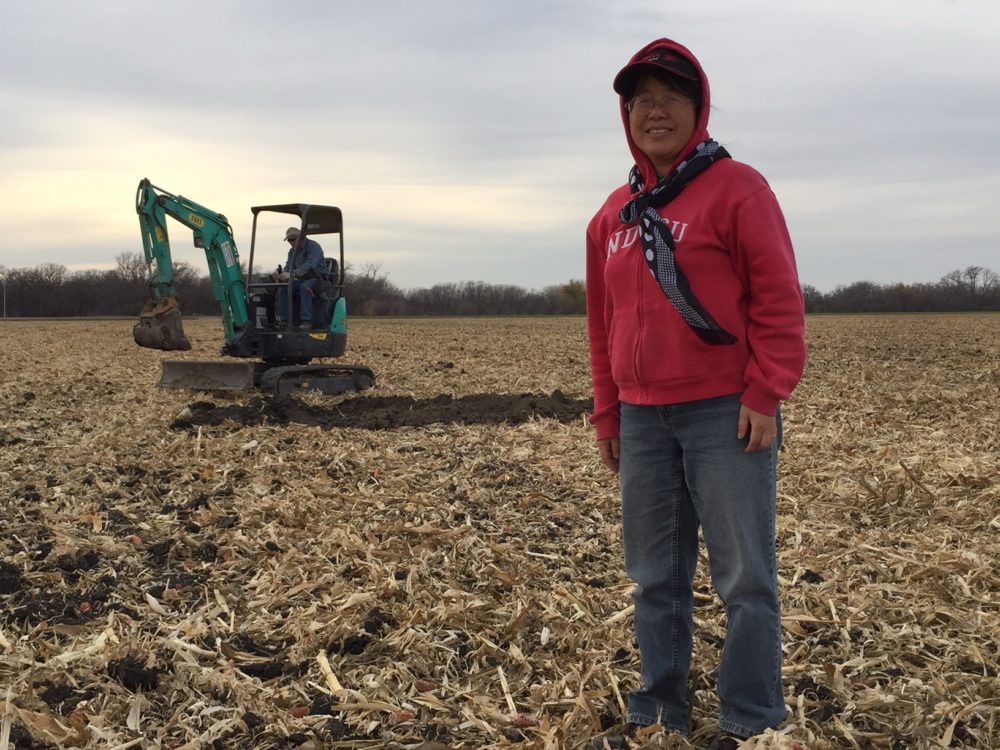
Xinhua Jia told me her research could benefit the entire globe.
Agriculture is king here in North Dakota. North Dakota arguably has more grain silos than people in particular areas. It is in those vital areas where crops make the money.
Ph.D. holder Xinhua Jia, professional engineer and associate professor from the college of agricultural and biosystems engineering, Dongquing Lin a technician and Ali Rashid Niaghi a graduate student, met with me to discuss the research happening in their college.
“Our research can be applied around the globe.” Jia told me. She first started field research at NDSU in 2007; currently there are two fields they conduct research at. The fields are located in Fairmount, ND and in Clay County, Minnesota.
They told me about crops and their need for water, but also how many problems can be caused by water. Jia told me that the education of research goes hand and hand with graduate and undergraduate students.
“We want our students to understand our program and to show their interest and then stay in our program. We don’t want our students to transfer out without knowing what is going on in our program.”
Jia told how students in some cases come from farming backgrounds and are able to leave the program and contribute to their farms back home and their communities. This type of research and education will continue for a long time.
“I strongly believe this research will go on as long as farmers still do farming.” Jia’s research is currently funded by grants from the United State Department of Agriculture (USDA) and the National Aeronautics and Space Administration (NASA) among others.
But research isn’t just about having a passion. It is also about getting the funding needed to continue your work. Something that can be feared when researchers depend on highly competitive grant money.
Budget cuts have affected the students, staff and faculty. Lin, a technician within the college, whose salary used to be 100 percent state funded, is now only 75 percent funded.
“If I don’t have the funding to support him, then he only gets 75 percent of his salary.” Jia told me this is a direct impact from the budget cuts. This isn’t just his position though, that is throughout the college of agriculture.
This would mean that Jia must take 25 percent of her funding away from her research and fund an expense that was not there before.
This doesn’t stop with the technicians. The graduate students that dedicate their time to these projects are in danger of cuts as well.
Currently the house just passed a tax reform bill that will radically change the landscape for all of the US’s graduate students. The most notable difference is taxation on tuition waivers.
According to the new GOP tax plan graduate students like Niaghi would have to pay taxes on their tuition that is waved.
This is a major problem for Niaghi.
“The biggest issue we have had is finances.” He told me that not only is his insurance expensive, but student fees and the rising cost of rent have been challenging.
Niaghi used to live on campus with his wife, noting he trusted the added security he felt. This is sadly not the case anymore. He has had to move after experiencing a rise of $100 a month for rent. This forced him to have to move away because he simply could not afford it anymore.
“We cannot afford it with our income as research assistants.” Niaghi is on a student visa; also meaning he will not have any income source outside of the stipend. With restrictions from Iran as well, he cannot get assistance from his family back home.
“When you’re stuck here, there is no way to get out.” Niaghi told me he likes it here, and that he is passionate about his research, but all of the other distractions can get hard. He said he has found that just focusing on his work is beneficial.
As it is now, graduate students pay taxes on their stipend. Which is comparable to the income you may get from working a minimum wage job. Adding tuition on it though makes the students look like they are making way more, in some cases above $50,000- $80,000 depending on their university.
Taxing a graduate student like they are making $80,000 is a reality that graduate students are having to visualize all across the country. Stretching a dollar can only go so far though.
For Niaghi and many others this is a major issue. With the current state of budget cuts and tax reform financial worries seem to be the status quo.
“The funding is cut everywhere.” Jia told me that although she has funding currently it is a struggle for all researchers to get the funding they need.
“We don’t know next time whether we will get it or not.” This is just the reality that researchers have to live.
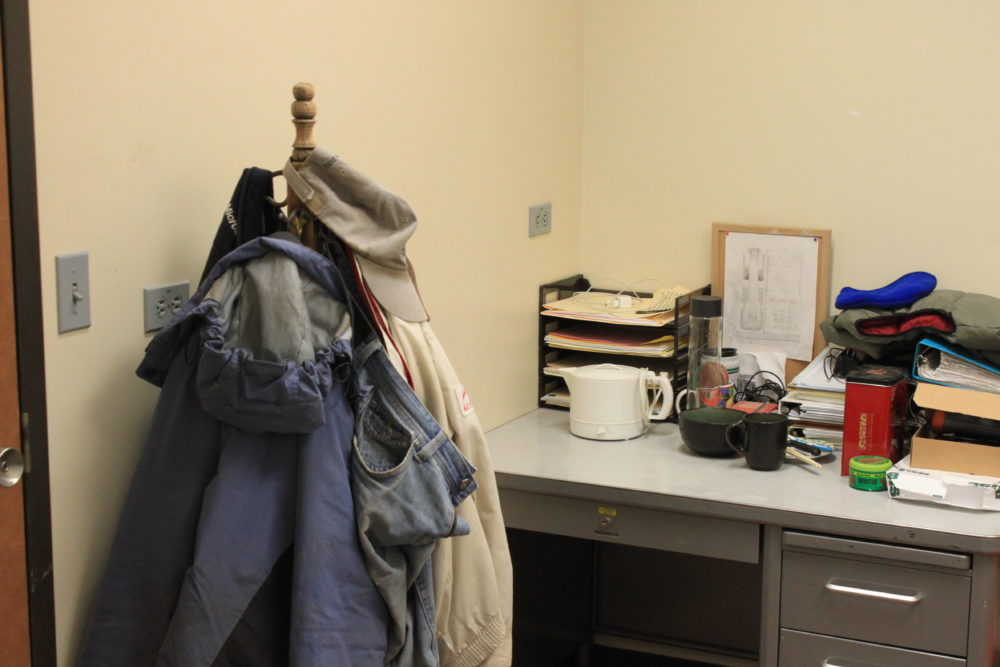
Within Jia’s lab, this office belongs to Dongquing Lin a technician.
I walked to Morrill Hall unannounced to meet with Jia. She is originally from the northwest part of China, and her office contains a large bookshelf stuffed with books. She told me that when she came to the US she was attracted by irrigation systems and found a passion for water management.
She obtained a PhD from The University of Arizona, but soon realized that after graduation a position in China, where she originally planning on going back, was no longer a possibility.
“I had to start from ground zero.” Jia welcomed my company as we walked down the corridors of Morrill Hall to her lab.
Lin was in the lab; he obtained his degree from the University of North Dakota. He told me that he just likes life here in the Midwest.
“I’m used to the life here, naturally, I like being here, it’s not a bad choice.” Lin’s choice to stay here is sadly challenged by a questionable future.
“I don’t know what the governor (Doug Burgum) has in mind for the university systems… for me I will try my best.” Niaghi echoes Lin’s hopes as well.
“We are living with hope.” Although these people are living with these doubts and questions, they are focused on providing answers to questions most people don’t even know are being asked. I can’t help but be amazed by their perseverance and dedication.
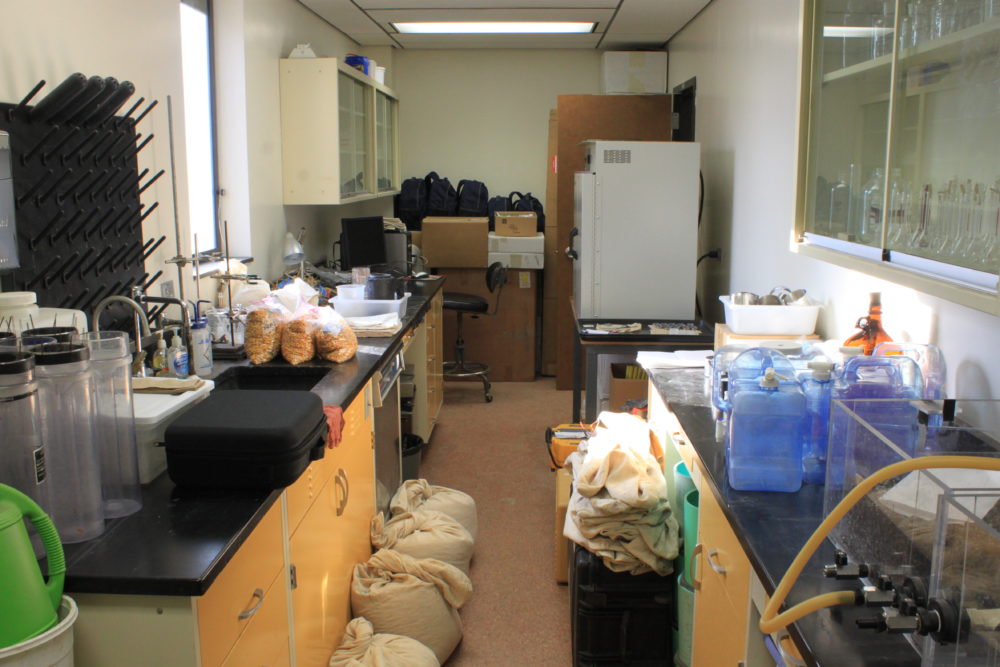
The inside of Jia’s lab contains many things I could only hope to name.
Jia’s lab is full of equipment and beakers. Corn sacks lay on the floor and a malt machine they use to mix dirt lies on the counter. Jia shows me around pointing to everything she can and gives descriptions. She is not going to stop her work; it is part of her life as well as many others around this country.
Jia has a college student she is supporting and grants to apply for. She tells me that this life has prepared her for life with budget cuts; she isn’t going to stop anytime soon.
“If you’re an easy quitter you will not be successful no matter where you are.”
The decision we had to make to protect people

Provost Beth Ingram and Vice President of Finance Bruce Bollinger talked about the state of the University and how we have handled budget cuts.
North Dakota several years ago was the envy of the entire union. Oil booming, money abundant, we seemed impervious to doing anything wrong.
Well, we as a state allowed fracking to happen as well.
“Our focus was people.” Provost Beth Ingram and Vice President of Finance Bruce A. Bollinger sat down with me to discuss budget cuts.
Ingram told me that the cuts were hard decisions between her and Bollinger, but President Dean Bresciani she said made it clear that people were the top priority.
According to Ingram the 186-full-time faculty leaving over the past four years is only slightly alarming, if at all.
Ingram pointed to our growth in faculty number, indeed a jump from 310 four years ago to 371 now. She noted that anywhere from five to ten percent of the faculty would leave every year roughly.
“We have a robust system for rehiring.” This system includes vetting by Ingram and the deans of the colleges. There are also allocation questions and shuffling around new positions, to try to improve the colleges the best they can.
The vast number of faculty that have left was aided by a program called the Voluntary Separation Incentive Program or VISP, which offers an early retirement package to aging staff and faculty.
In an email by Media Relations Coordinator Sadie Rudolph I was given the specifics,
“The office of Human Resources and Payroll indicated the number of positions eliminated due to the Voluntary Separation Incentive Program (VSIP) are 38 plus 3 three phased faculty retirements.”
Although this sense of weathering the storm is brighter in North Dakota, this doesn’t speak for the region. The state of higher education is in trouble, budget cuts within our region has put a lot of states in fear.
“There is a lot of concern out there for support for public education.” Ingram told me that there isn’t much concern for NDSU though. The main concern, at least for now is for smaller institutions within the region.
“Your university is either going to grow and thrive, or your future is going to be pretty bleak.” Ingram told me NDSU has grown and currently looks to be on a growing pattern, our current freshmen class is one of the largest in school history.
North Dakota had the west side of the state almost printing money. The state of higher education, in a way was spared the degree of severity that other states like Wisconsin, Iowa and Illinois are dealing with.
Illinois, who recently passed their budget for 2018, has had seven universities be downgraded, with five being listed as ‘junk-credit’ by Moody’s (a credit rating site). NDSU is doing, when compared to those states, much better.
Fears are mounting for future cuts though. The current GOP tax plan will seek to cut more from higher education. According to The Atlantic, Currently Trump’s tax plan will seek to cut,
“funding by between 11 percent and 18 percent for the federal agencies that provide the bulk of government support for university research.”
“I don’t think that will happen.” Ingram told me the partnership between the nation’s government and research is well documented.
“It would be a difficult transition… research is expensive.” She said that if this move happened she would suspect research to slow down a bit. According to Bollinger the whole picture needs to focus on the support from our state though.
“The state does support higher education, it’s just the economy couldn’t support it.” Bollinger said, Ingram told me that we are generously supported.
“We have been very lucky.” Bollinger’s view and Ingram’s is that the legislation of the state has put higher education as a top priority. Being a top priority amongst budget cuts isn’t always the easiest position to be in though. Recalling Jia’s struggles and Niaghi’s worries, budget cuts become much more pliable and real.
As for graduate student’s possibly being taxed for the their tuition waivers, Ingram was noticeably put off by it. She noted that this major deal for graduate students was only a small part of the plan, but vitally important for us to notice.
“Not a lot of American will pay attention to it, because they don’t have regular interaction with graduate students. I know our graduate council just penned a letter to send off to our congressional delegation on this.”
Ingram is hopeful for a better outcome; she does believe priorities need to be set. As far as supporting research technicians, Ingram stated that our state is a rarity, in that we allocate state money for those research technicians.
“We are moving to a model that many other states have, and that is you have to support that position (technician) with grants.” This model though still affects the researchers within this state and here in Fargo. A decision being commonplace doesn’t help the people dedicating their lives to research and innovation.
It seems the future may be bright when looking at the numbers. Our university will grow and maintain a strong student base. The changes we make to protect people will take some getting used to for the very people it sought to protect.
Student Focused, Land Grant, Research University
As I drive my car into Fargo it is hard to not see the way NDSU has grown this town and attracted business and opportunity.
It is also not hard to hear the complaints of those around us. The complaints from those who feel the budget cuts everyday. It is easy to hear the fear for a tax plan that will radically change the landscape of higher education within this country, but particularly in this region.
No graduate student is living over his or her means. No research technician is doing their job for the money; rather there is a passion for knowledge and a want to better humanity.
Fargo will be fine in the long run, in part to NDSU being fine in the long run. We need to focus on the whole picture though. The researchers within our university, they need our support and they need their stories heard.
The research universities in this region are vital for the nation as a whole. No one know where innovation is going to come from, but the government has allocated $42.46 billion annually to research universities for their research. This produces 2,600 patents and 400 companies a year.
If we really want to make America great again it will start at investing in a higher education system that has propelled the US as a global superpower for innovation for decades.
It will not come from further cuts to research. It will not come from taxing poor graduate students.
According to Rebecca Blank, the chancellor for The University of Wisconsin in The Atlantic,
“We’ve been in the lead long enough that people think we always will be, [but] we cannot assume that we are going to lead the world in technology 20 or 30 years from now, I think we’ve stalled out.”
